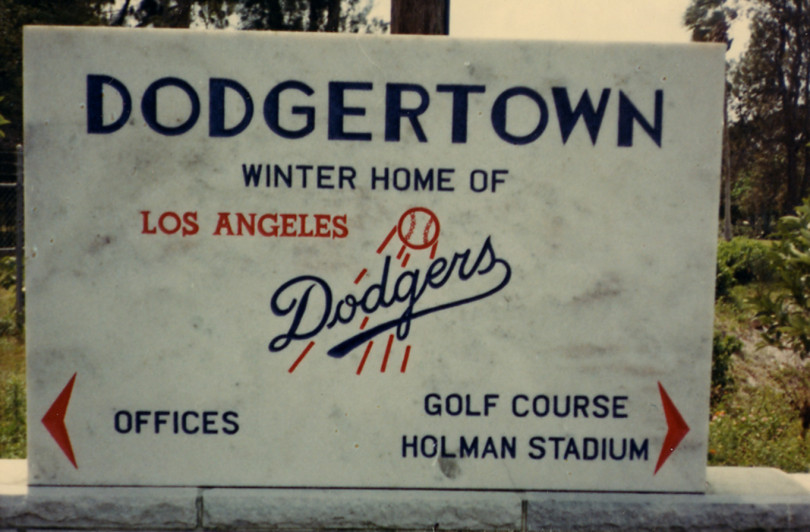
Circa early 1960s, the iconic Dodgertown marble marker created by Domar Corporation in Vero Beach, Florida identifies the location of Dodgertown offices, Holman Stadium and golf course with the Dodger logo.
Feature
Dodgers, O’Malley Family Ties To Vero Beach Community
By Brent Shyer
The Dodgers and the O’Malley family developed lasting bonds with the Vero Beach, Florida community beginning in 1948. It became an annual second home for the family, players and staff with numerous local friendships forged. Like a favorite well-worn loafer, there was great comfortableness in Vero Beach.
During their seven-decade long marriage, the Dodgers greatly contributed to shaping Vero Beach. As the city grew and offered more to the community, the Dodgers were in lock step furthering development, investment and expansion at Dodgertown.
What the O’Malley family left is an enduring legacy thick in tradition. Year by year, the improvements to the site were part of a labor of love for Vero Beach to give players, coaches, executives, medical personnel, the press and fans a place to enjoy baseball in its simplest form. There was a togetherness on the small college campus-like atmosphere and fans were the beneficiaries of seeing the Dodgers up close and in person with minimal barriers. There truly was nothing like it anywhere else in baseball, which is why it continues to be discussed with a passion by anyone who was fortunate enough to experience Dodgertown.

1951 Spring Training, Dodger pitcher Rex Barney signs autographs for fans at Dodgertown, Vero Beach, Florida. Barney enjoyed the community and became a longtime Vero Beach resident.
Photo by Peter O’Malley. All Rights Reserved.

Caption of photo handwritten by 13-year-old Peter O’Malley at Dodgertown, Vero Beach, Florida during Spring Training, 1951. Pitcher Rex Barney worked for years tending bar at The Patio Restaurant & Lounge in Vero Beach.
Photo by Peter O’Malley. All Rights Reserved.
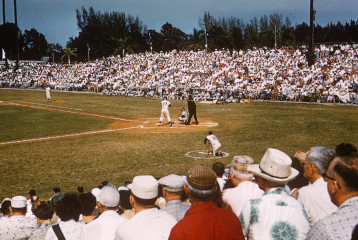
1956 Dodger exhibition game at Holman Stadium, Dodgertown, Vero Beach, Florida. Dodger outfielder Don Demeter (No. 27) is hitting with Dodger Hall of Fame catcher Roy Campanella (No. 39) waiting on deck. Holman Stadium featured open air dugouts so fans were in close proximity to the players and the game action.
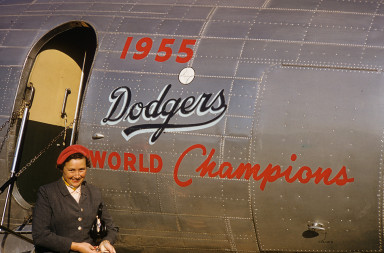
In the fall of 1955, Kay O’Malley, wife of Walter, next to the Dodgers’ DC-3 plane with the new logo of the 1955 World Champions. The five Dodger-owned airplanes for many years were based in Vero Beach.
Each spring started when one of the five Dodger-owned airplanes, starting in 1950 with a DC-3, would fly directly into the Vero Beach Municipal Airport adjacent to Dodgertown, the former U.S. Naval Air Station built during World War II. Fans lined the edge of the tarmac and the Vero Beach High School band would play to welcome the arriving Dodgers off the plane and back “home”. It became an annual rite of passage for city fathers, Indian River County officials and fans to join together and watch their heroes return to Vero Beach, like the infamous swallows returning to San Juan Capistrano. Interestingly, in 1949, the Dodgers’ first full spring in Vero Beach, their special train from New York was greeted by city officials and fans at the station.
The Vero Beach Press Journal issued special sections about the Dodgers during Spring Training. The first appearance in Vero Beach of the Dodger-owned airplane was a new beginning, an indicator that spring had arrived. Winter was behind and familiar baseball activities were about to commence.
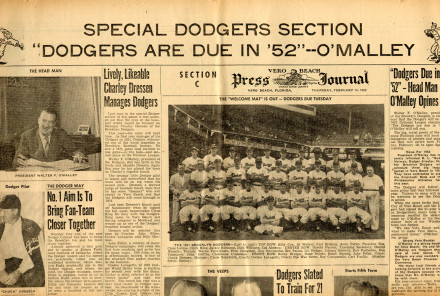
February 14, 1952, special section of the Vero Beach Press Journal on the arrival of the Brooklyn Dodgers to Vero Beach for Spring Training. For years, the Press Journal annually produced a special section about the Dodgers as Spring Training began.
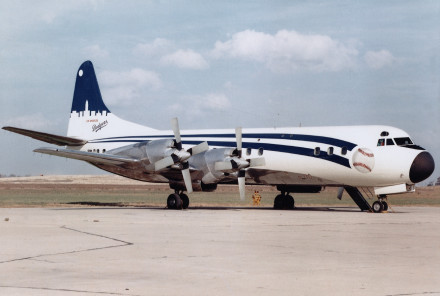
The Dodgers used their Lockheed Electra II from 1962-70, until the team purchased a Boeing 720-B fan jet. The Electra, named for Kay O’Malley and called “Kay O’”, was frequently seen at Vero Beach, Florida Airport.
In 1954, Dodger President Walter O’Malley initiated a Dodgertown Summer Camp for Boys (8 weeks from July-August), bringing youngsters from throughout the country to stay at Dodgertown and participate in a variety of sports and recreational activities in Vero Beach. The popular camp was held for nine years. For several summers, O’Malley’s daughter Terry served as secretary to the camp supervisor, while his son Peter was a camp counselor. In 1957, O’Malley welcomed representatives and two players from the Tokyo Yomiuri Giants to Dodgertown. International teams from Asia began training at Dodgertown in 1961, another boon to the area.
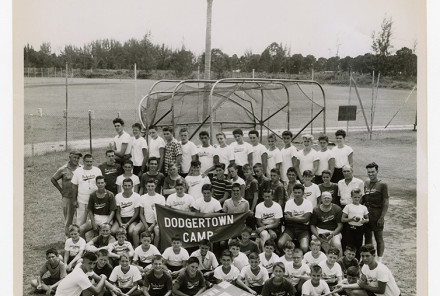
July, 1954, the inaugural two-month Dodgertown Summer Camp for Boys, Vero Beach, Florida. A group of campers at Field No. 1 with camp counselor Peter O’Malley, seated in the third row, fourth from left, just behind letters “Dod” in the Dodgertown Camp banner.
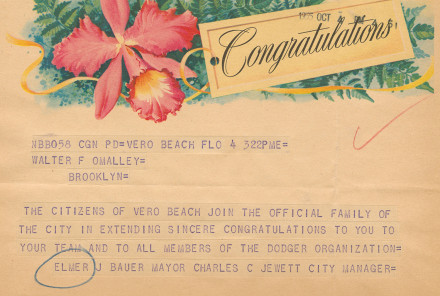
Vero Beach Mayor Elmer Bauer with City Manager Charles Jewett express in an October 4, 1955 telegram their pride for the contribution made by Dodgertown, Vero Beach, Florida on the occasion of the Dodgers’ first World Championship that season.
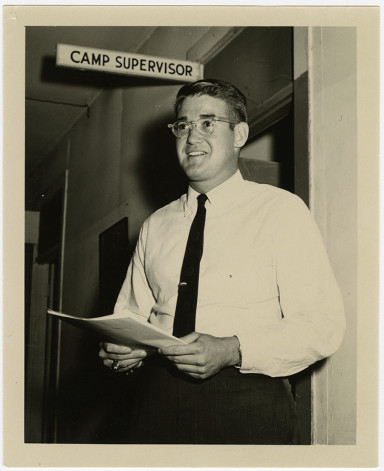
From 1962-1964, Peter O’Malley was Director, Dodgertown, Vero Beach, Florida and was responsible for the entire camp complex. At the time, the Dodgers were occupying the former U.S. Naval Air Station barracks.
Peter O’Malley’s first job upon graduation from the University of Pennsylvania was Director, Dodgertown in October, 1961. The previous spring, he was responsible for all arrangements and scheduling for the Tokyo Yomiuri Giants from their arrival to their departure at Dodgertown. He said of the new assignment, “Dodgertown is the most extensive spring training camp in existence and the only one where all minor as well as major league players are trained in one camp. It is of interest to note that this is the only training base ever built and maintained by a major league club. We will house, feed, bed and train 500 baseball players, as well as sportswriters and staff, from February through April. A number of capital improvements are planned in keeping with our long range plans under our lease which does not expire until 1994.” Vero Beach Press Journal, October 19, 1961
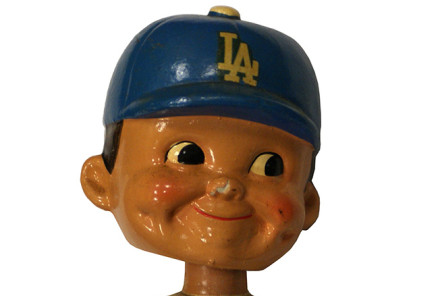
In spring 1963, Dodgertown Director Peter O’Malley gave shopkeepers posters and bobbleheads like the one shown to display in their windows.
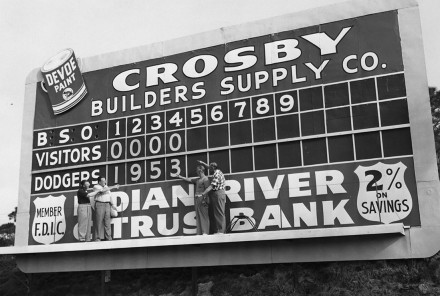
Dodger Manager Charlie Dressen, Dodger President Walter O’Malley, Dodger Vice President Fresco Thompson and an unidentified person stand on the new Holman Stadium scoreboard as the Dodgers prepare for the 1953 season at Dodgertown, Vero Beach, Florida.
In 1962-1964, each February as Director, Dodgertown, Peter O’Malley went from business to business in downtown Vero Beach to share schedule posters and Dodger bobblehead dolls for their windows. He also sold ads for the Spring Training game programs, which were always enthusiastically supported. The Dodgers had a huge impact on the growth and visibility of Vero Beach, with datelines stretching worldwide by sportswriters in New York, California and everywhere in between.
The economic impact was also substantial as local contractors were hired for construction and maintenance projects, laundry, printing, photography, and countless supplies including regular deliveries of milk and food for the team. Dodgertown itself hired staff to work in the kitchen and dining room, accommodations, grounds crew, offices, front desk, and security. Area hotels, restaurants, shops and recreational activities all benefitted from the Dodger spring activities, not only from the Dodger organization but from the thousands of tourists who made the annual trek to watch them train and play. Sponsors were excited about connecting with Dodgertown, especially during Spring Training activities and the community was abuzz.
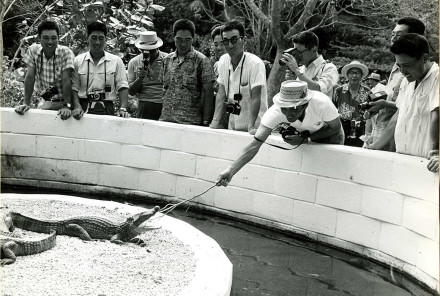
Before the 1961 season, the professional Tokyo Yomiuri Giants spent spring training at Dodgertown, Vero Beach, Florida. It marked the first time a team from Japan had trained with a major league team in the pre-season. The O’Malley family suggested a Giants’ visit to renowned local tourist attraction McKee Jungle Gardens. The Giants visited Dodgertown for spring training on five occasions, winning four Japan Series in those years.
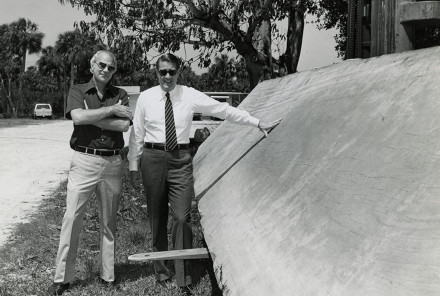
In 1976 when McKee Jungle Gardens, Vero Beach, Florida was closing and selling items, Dodger President Peter O’Malley (right) met with Arthur McKee Semon (left), grandson of Arthur McKee who co-founded McKee Jungle Gardens. O’Malley purchased the world’s largest one-piece mahogany table (35’ long). When McKee Gardens re-opened in 2001, O’Malley loaned the table for display and eventually donated the table in 2022.
Some favorites included Alma Lee’s children’s clothing shop, The Ocean Grill restaurant, Skiscim’s Camera Shops, Loy’s Men’s Wear, Tripson Dairies Inc., Rice Bros. Laundry, Vero Beach Cadillac, McKee Jungle Gardens, Indian River Citrus Bank, Domar Corporation, Vero Beach Press Journal, Hale Groves, WAXE Radio AM 1370, Emlet’s restaurant, Jerre Haffield Packing House, Parent Construction, Inc., Driftwood Inn, McClures Rexall Drug Store, Lennie’s Lounge & Package Store, Barrett’s Steak House, The Patio Restaurant, Wodtke’s, Norris’ Record Center, DuBose Jewelry Company, Vero Beach Book Center, Vero Bowl, and WTTB Radio AM 1490, and more.
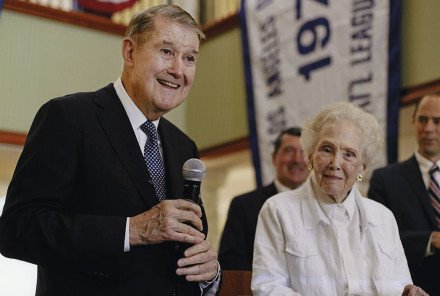
November 5, 2019, Indian River County administration building, unveiling of Dodgertown, Vero Beach, Florida model circa mid-1950s. Peter O’Malley with First Lady of Vero Beach Alma Lee Loy. In 2012, the trusted civic leader was honored by the community as the 17th Street Bridge spanning the Indian River was re-named “Alma Lee Loy Bridge” in 2012.
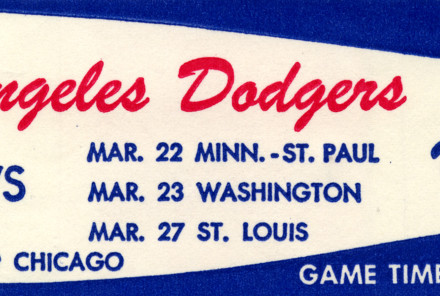
Local Vero Beach, Florida business Rice Brothers Laundry used this 1961 Dodgers’ spring schedule as a wrap-around shirt binder.
On September 23, 1964, the Dodgers purchased 110.4 acres of airport land for $133,087.50 from the City of Vero Beach. The agreement, approved by the Federal Aviation Agency, benefited the city’s general fund as the land went on the property tax rolls. On March 19, 1965, the City of Vero Beach finalized the agreement with the Dodgers, who became the only major league club in Florida to own and maintain their own Spring Training site. In later years, the Dodgers purchased another 340 acres to expand their base.
Two golf courses were privately built by Walter O’Malley and open to the community. A nine-hole course, Dodgertown Golf Club, was built in 1965 and dedicated in the spring of 1966. In 1971, 18-hole Safari Pines Country Club was opened to the public. The name was subsequently changed to Dodger Pines Country Club. A rare and challenging par-6, 670-yard hole was part of the course. Safari Pines Estates, a modular home community, developed around the southeast side of the 18-hole golf course. In 1976, clubhouses were added for the benefit of the golfers at the popular courses.
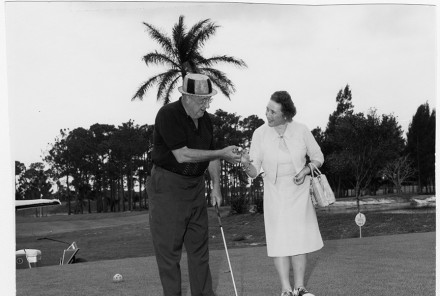
Dodger President Walter O’Malley and his wife Kay are on the Dodgertown Golf Course in Vero Beach, Florida in 1966, the year it was dedicated during Spring Training. O’Malley privately built the public golf course so all Dodger players could enjoy the recreational activity.
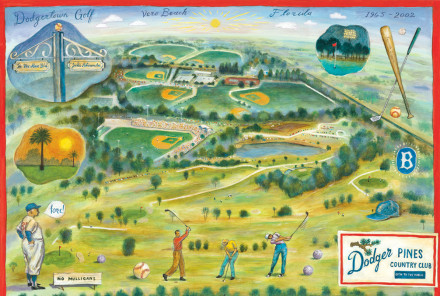
Original artwork by artist John Dykes which accompanied an article in Golf World on the history of the 9-hole Dodgertown Golf Club and the 18-hole Dodger Pines Country Club, Dodgertown, Vero Beach, Florida. Dodgertown Golf Club was the first local public course and privately built by Walter O’Malley so that Black players had an opportunity to play golf during Spring Training.
In 1978, Craig Callan began working at Dodgertown for Harrison Conference Centers. By 1988, he was named Director, Dodgertown. Callan spent 40 years at Dodgertown through 2018 with a title of Vice President responsible for its operation, development and maintenance while connecting with the local community as point person for the O’Malley family.
The Dodgers worked closely with St. Helen Catholic Church in Vero Beach for decades. In fact, Dodgertown was the regular site of the annual St. Helen’s Harvest Festival with activities for the entire parish family and visitors of all ages, including rides, contests, drawings, hand-crafted gifts, and concession stands. The fall festival was located adjacent to iconic Holman Stadium. St. Helen’s also held Easter Sunrise Services at Holman Stadium. Through the years, charity firework shows were held on the Fourth of July at Holman Stadium.
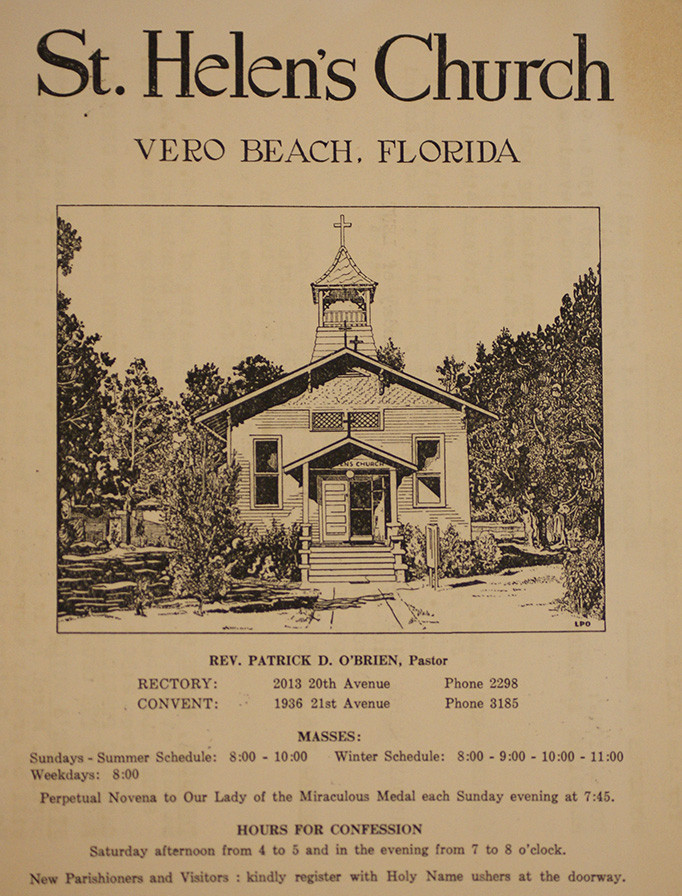
Bulletin for St. Helen’s Catholic Church, Vero Beach, Florida, circa 1960s. The current sanctuary for St. Helen’s opened in 1969. For decades, the Dodger organization and St. Helen’s enjoyed a close friendship. Dodgertown was the site of the church’s Annual Harvest Festival and Easter Sunrise services.
In 1986, the Dodgers adopted a local elementary school and the Los Angeles Times reported in March, 1987: “This is the first Spring Training, the Los Angeles Dodgers attend events and activities at the recently named Dodgertown Elementary School. The Vero Beach grade school, formerly known as ‘Clemans Elementary School,’ was changed to Dodgertown Elementary by the Indian River School District. Jerry Crowe, Los Angeles Times, March 1, 1987 “The whole school changed personality,” said Principal Bonnie Swanson. Hometown News, Vero Beach, March 21, 2008 The school was painted to match the blue and white colors of the Dodgers and (Dodger Manager) Tom Lasorda and other Dodger players appeared at the school to provide messages of education and sportsmanship. J.B. Norton, Executive Director of the Vero Beach, Florida, Chamber of Commerce spoke of the importance of the Dodgers’ appearance and estimated the team provided $30 million to the local tourist economy. Norton said, “I can't put a figure on the dateline. It’s just phenomenal. We, as a community, would never be able to purchase that type of advertising. Anywhere I go, the minute I say I’m from Vero Beach, there is an immediate response that I get. ‘Oh, the Dodgers are there.’ That type of publicity you can’t put a dollar figure on. It’s just tremendous.” Jerry Crowe, Los Angeles Times, March 1, 1987
The Dodgers invested in a new outdoor classroom, new signage, painting, landscaping and equipment, while also sending Dodger players to the school to speak about the importance of education, discipline and drug abstinence. The Little Dodgers of Dodgertown Elementary School were frequent guests of the Dodgers at Dodgertown and Vero Beach Dodgers games. The school held their graduation ceremonies before a Vero Beach Dodgers (Single-A) Florida State League game at Holman Stadium. The Dodgers always strove to be good neighbors in the city.

A 1988 bumper sticker shows the strong bond between Vero Beach, Florida and the Dodger organization. The Dodgers first arrived in Vero Beach, Florida in 1948 establishing Dodgertown and 40 years later the community ties continued to thrive.
Peter O’Malley said in 1991, “I’ve been coming here every year since I was a kid. Haven’t missed a year yet. And having worked here as I did in the early ‘60s running the camp, every tree here I’ve seen grown. The fields develop. There’s a lot of pride right here, as well as Dodger Stadium. There’s a lot of enjoyment, because looking back, we’ve done it well. I learned how to drive on this street when I was 15 years old. I remember washing (Dodger pitcher) Joe Black’s car. I remember when the lake was built behind Holman Stadium. We went and got a dozen ducks and we put them over there and fed them and they stayed for years. I remember when the golf course was built, Holman Stadium, the new buildings. The St. Patrick’s Day party we held. I could go on forever.” Steve Dilbeck, San Bernardino Sun, March 10, 1991
That same year, O’Malley purchased an ad in the Vero Beach Press Journal stating, “To our friends in Indian River County: The Dodgers have just concluded our 44th consecutive year of Spring Training in Vero Beach. Throughout the years we have been fortunate to have the loyal support of so many people in the county. We appreciate everything you do for us to make our spring visit each year so enjoyable." Vero Beach Press Journal, ad, April 5, 1991
On April 15, 2014, Minor League Baseball President Pat O’Connor inaugurated the annual Jackie Robinson Celebration Game at Holman Stadium, which was a regular-season Florida State League game between the Brevard County Manatees and the Lakeland Flying Tigers. Working closely with Historic Dodgertown Chairman Peter O’Malley, the annual game was to remember Jackie Robinson’s critical role in the integration of Dodgertown in March 1948, as well as on the anniversary of his initial game for the Brooklyn Dodgers on April 15, 1947, becoming the first African American to play Major League Baseball. Net proceeds from the annual celebration benefitted the United Way of Indian River County.
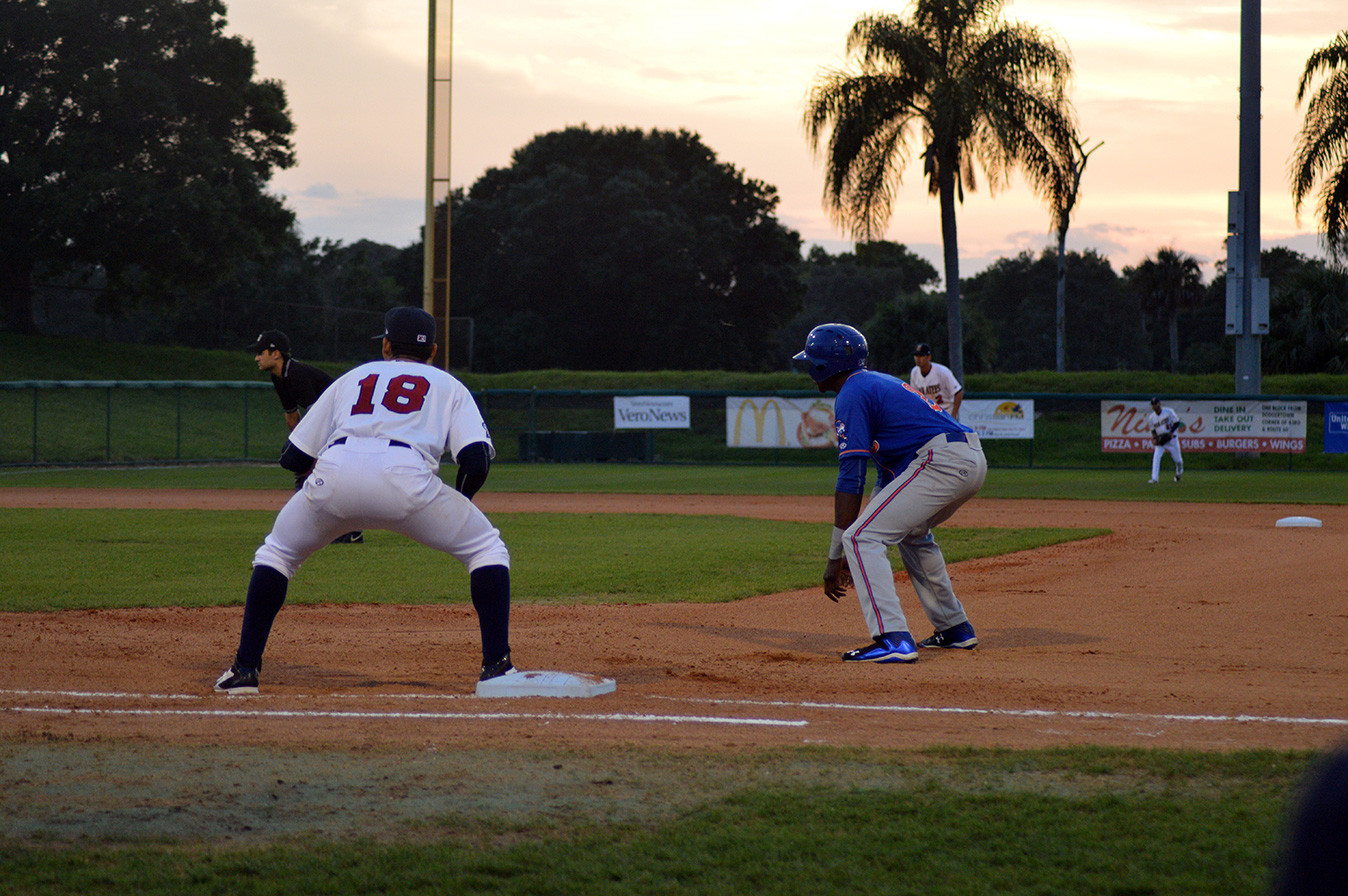
The 3rd Annual Jackie Robinson Celebration Game was played April 15, 2016 at Holman Stadium, Historic Dodgertown, Vero Beach, Florida. St. Lucie played Brevard County in a regular season Florida State League game, with net proceeds benefiting community service programs through the United Way of Indian River County.
On November 10, 2014, Historic Dodgertown was recognized by the state of Florida as a Florida Heritage Landmark. The efforts for this recognition were guided by the Indian River County Historical Society and a permanent marker was installed at the walkway to the Conference Center at Dodgertown (now the Jackie Robinson Training Complex). Ruth Stanbridge, Indian River County Historian and former County Commissioner, said, “For years as the County Historian, I had wanted to write the perfect historic marker for Dodgertown. It was to reflect on how our WWII training fields had been turned into a ‘field of dreams’ for decades of young men of all races who only wanted to play baseball.”
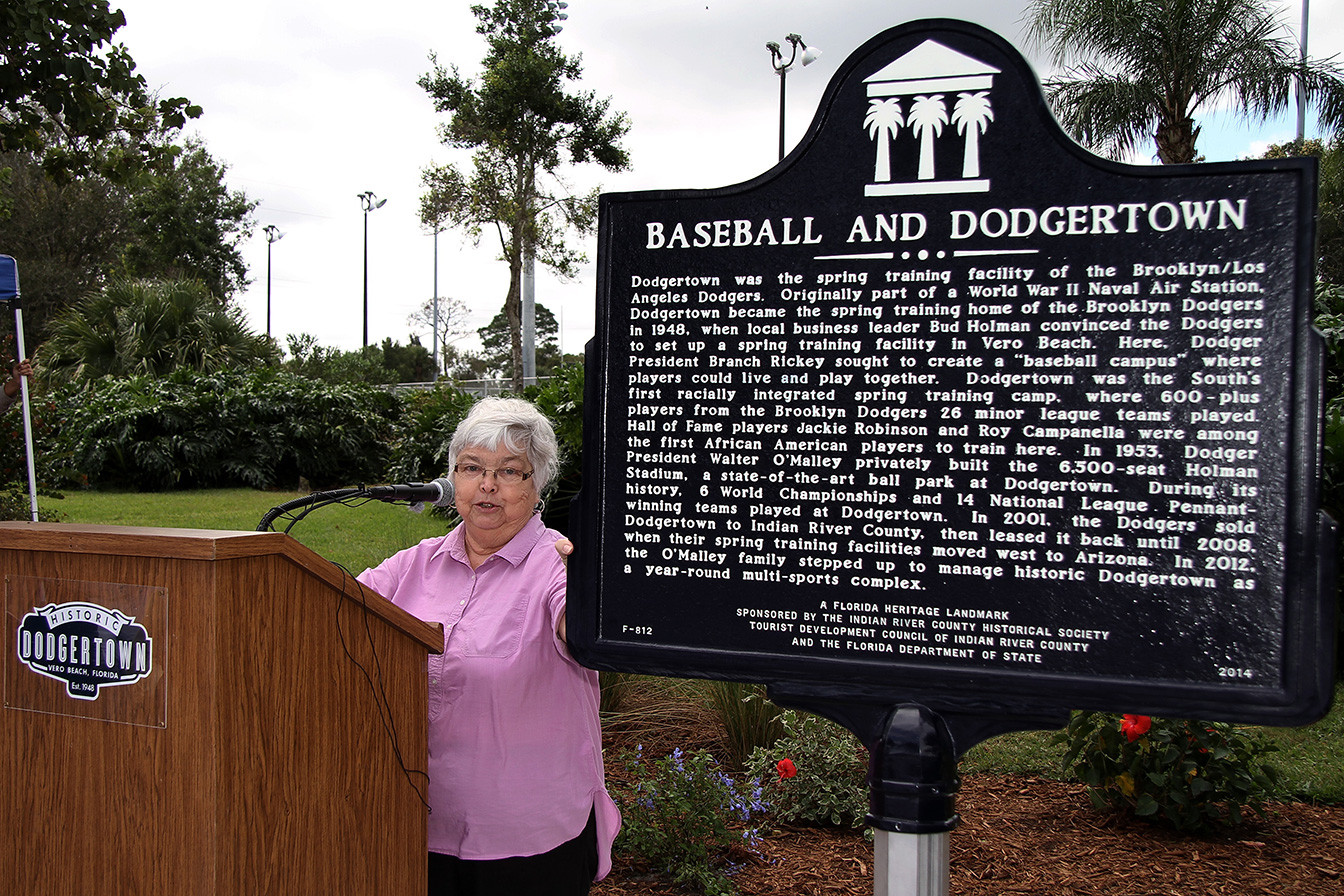
November 10, 2014, Historic Dodgertown, Vero Beach, Florida, Ruth Stanbridge, Indian River County Historian and former County Commissioner, speaks to Dodger legend instructors, campers, and guests at the 53rd Annual Los Angeles Dodgers Adult Baseball Camp during unveiling ceremonies for the historic marker “Baseball and Dodgertown”, making the site a Florida Heritage Landmark.
Historic Dodgertown played a significant role in U.S. Civil Rights history, and in 2019 it was honored with its inclusion on the U.S. Civil Rights Trail. Historic Dodgertown is the only sports property on the U.S. Civil Rights Trail, which is a collection of churches, courthouses, schools, museums and other landmarks primarily in the Southern states where activists challenged segregation in the 1950s and 1960s to advance social justice. The Trail’s motto is “What Happened Here Changed the World” and as one of its significant locations Dodgertown certainly helped to do that.
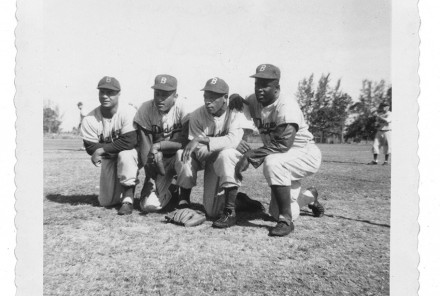
March, 1950, (L-R): Roy Campanella; Don Newcombe; Dan Bankhead; Jackie Robinson. Four record-setting African American Dodgers are at Dodgertown, Vero Beach, Florida. Dodgertown was MLB’s first fully-integrated spring training site in the South. Photo by Peter O’Malley (age 12). All Rights Reserved.
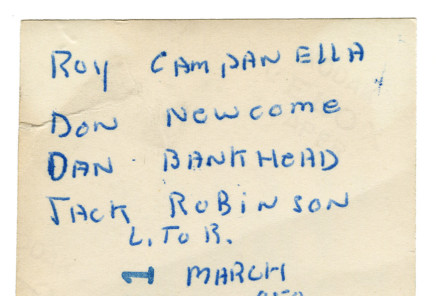
Caption written by 12-year-old Peter O’Malley on the back of a photo he took of Roy Campanella; Dan Bankhead; Don Newcombe, and Jackie Robinson, March, 1950, Dodgertown, Vero Beach, Florida. All Rights Reserved.
Peter O’Malley recalled the meaning of Dodgertown in 2011, “Well, my sister Terry, and I started out down there as kids on spring break and then when we had the boys camp in the summer in the 50s, I was a counselor for one group. Terry was the secretary for the camp director, and we’ve gone back every year since. We have slept there more nights in our lifetime than probably (all the other places in the world) combined. I ran it for two years and that wasn’t just for spring training in the 60s. I would get down there in January and not leave until probably the first of May. So, we’ve spent a lot of time there. And we’ve seen the city grow in a very classy way. Vero Beach is like being your best friend.” Ed Bierschenk, Indian River Press Journal, November 23, 2011

